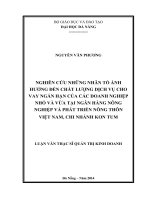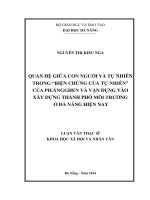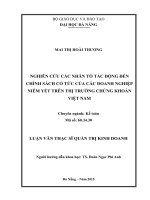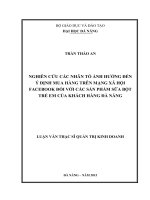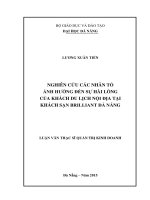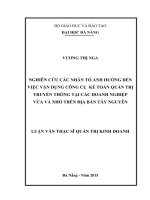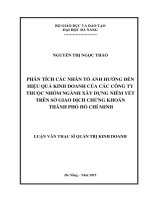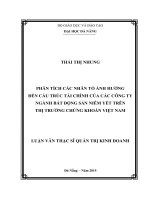Luận văn Thạc sĩ Teaching English as a foreign language to students at a blind school in Hanoi
Bạn đang xem bản rút gọn của tài liệu. Xem và tải ngay bản đầy đủ của tài liệu tại đây (525.57 KB, 84 trang )
VIETNAM NATIONAL UNIVERSITY, HANOI
UNIVERSITY OF LANGUAGES AND INTERNATIONAL STUDIES
FACULTY OF POST-GRADUATE STUDIES
------
HOÀNG THỊ TRANG
TEACHING ENGLISH AS A FOREIGN LANGUAGE
TO STUDENTS AT A BLIND SCHOOL IN HANOI
(Nghiên cứu về việc dạy Tiếng Anh như là một ngoại ngữ cho học sinh
khiếm thị ở một trường chuyên biệt ở Hà Nội)
M.A. Minor Thesis
Field: English Teaching Methodology
Code: 8140231.01
HANOI – 2020
VIETNAM NATIONAL UNIVERSITY, HANOI
UNIVERSITY OF LANGUAGES AND INTERNATIONAL STUDIES
FACULTY OF POST-GRADUATE STUDIES
------
HOÀNG THỊ TRANG
TEACHING ENGLISH AS A FOREIGN LANGUAGE
TO STUDENTS AT A BLIND SCHOOL IN HANOI
(Nghiên cứu về việc dạy Tiếng Anh như là một ngoại ngữ cho học sinh
khiếm thị ở một trường chuyên biệt ở Hà Nội)
M.A. Minor Thesis
Field: English Teaching Methodology
Code: 8140231.01
Supervisor: Prof. Dr. Nguyễn Hòa
HANOI – 2020
DECLARATION
I certify that the thesis entitled “Teaching English as a Foreign Language to
students at a Blind school in Hanoi” is the results of my own research for the
Degree of Master of Arts at The University of Languages and International Studies
– VNU, Hanoi, and the substance of this research has not been submitted for a
degree to any other university or institution wholly or partly.
Signature
Hoang Thi Trang
Hanoi, 2020
i
ACKNOWLEDGEMENTS
This thesis could not have been completed without the help and support from a
number of people.
First and foremost, I would like to express my deepest gratitude to my supervisor,
Professor. Nguyen Hoa who has given me much invaluable advice and
encouragement since the beginning and has always been my frequent secure of
many valuable insights. I am also grateful to his for reading my manuscript and
helping me make the necessary changes.
In addition, I would like to send my sincere thanks to all of the lecturers of the
Department of Post Graduate Studies, Vietnam National University for their useful
lectures and materials which are great of value to my thesis.
A special word of thanks goes to all the teachers and students at School X for their
participation in completing the project.
I also want to send my appreciativeness to my family, my friends and other people
who have encouraged, assisted and supported me during the process of this project.
Finally, due to the limited time to complete this work, it is unavoidable to have the
mistakes; therefore I am solely responsible for them and would like to have
comments from others who concern to my study.
Hanoi, September 2020
Hoang Thi Trang
ii
ABSTRACT
In an attempt to investigate the reality of English teaching and learning in a
secondary school for the disabled (the Blind and Visually Impaired) in Hanoi
(hereinafter called School X), the main purposes of the research were to find out:
(1) the reality in teaching and learning English to blind and visually impaired
students; (2) the difficulties in teaching and learning English via the teachers and
students‟ self- reported difficulties they faced with; (3) the reasons why the teachers
and students have these difficulties in teaching and learning English; (4) the ways to
help teachers and students reduce difficulties they have in teaching and learning
English. To conduct the research, I used the descriptive qualitative method. The
subjects of the study were eight randomly selected blind and low- vision students
and four English teachers at School X. The data was collected from class
observation and interview. The results of the research shows that: (1) The process in
teaching and learning English to visual impaired students in inclusion class at
School X are still teacher- centered, so the students are learning depend on the
teacher‟s instruction; the English materials for visually impaired students are same
with normal students; (2) The problems faced by teachers and visual impaired
students in teaching and learning English in inclusion class; (3) The solving of the
problems faced in teaching and learning English by teachers and visual impaired
students.
It is hoped that this thesis will improve the teaching and learning English process
more successful at School X in particular and all the secondary schools for blind
and low vision students in general.
Key words: visually impaired students, language learning, language teaching,
challenges
iii
TABLE OF CONTENTS
iv
LISTS OF TABLES
Table 1: Students‟ reasons for learning English (N=8) ............................................28
Table 2: Students‟ opinions about the importance of learning English (N=8) .........28
Table 3: Students‟ opinions about the importance of learning English in comparison
with other subjects (N=8) ..........................................................................................29
Table 4: Students‟ opinions about their passion learning English (N=8) .................29
Table 5: Students‟ learning competence (N=8) ........................................................29
Table 6: Students‟ opinions about the importance of good marks (N=8) .................30
Table 7: Students‟ attitude to English lessons (N=8) ................................................30
Table 8: Students‟ feeling in English lessons (N=8) ................................................30
Table 9: Factors affecting students in learning English (N=8) .................................31
Table 10: Students‟ opinion when they are learning English in class (N=8) ...........32
Table 11: Students‟ opinion when having difficulties in learning English (N=8) ....32
Table 12: Students‟ opinion about the most difficult aspect (s) in learning English
(N=8) .........................................................................................................................33
Table 13: Students‟ opinions about English learning activities (N= 8) ....................34
Table 14: Students‟ materials for learning English better (N=8) ..............................34
Table 15: Students‟ evaluation on their textbooks (N=8) .........................................35
Table 16: Students‟ difficulties in learning English (N=8) .......................................35
Table 17: Students‟ solutions to improve their English (N=8) .................................36
Table 18: Students‟ suggested solutions to improve their English (N= 8) ...............36
Table 19: Information about teachers participating in the survey (N= 4).................37
Table 20: Teachers‟ years of teaching English and teachers‟ years of teaching
English to blind and low vision (N=4) ......................................................................37
Table 21: Teachers‟ training background (N=4).......................................................37
Table 22: Teachers‟ opinions about the importance of teaching and learning English
(N=4) .........................................................................................................................38
Table 23: Teachers‟ opinion about the importance of learning English in
comparison with other subjects (N=4) ......................................................................38
Table 24: Teachers‟ and students‟ opinions about student‟s passion learning English
(N=4) .........................................................................................................................39
Table 25: Teachers‟ judgment about students‟ learning competence (N=4) ............39
Table 26: Teachers‟ attitudes toward English teaching aim (N=4) ..........................39
Table 27: Aspects that teachers‟ focus on in their teaching English (N=4)..............40
v
Table 28: Teachers‟ opinions about the most suitable method for their teaching
English (N=4) ............................................................................................................40
Table 29: Techniques are often used by teachers in teaching English (N=4) ...........41
Table 30: Ways of using the textbook of the respondents (N= 4) ............................42
Table 31: Frequency of using other materials besides the textbooks in teaching
English (N= 4) ...........................................................................................................42
Table 32: Frequency of using the mother tongue in teaching English of the
participants (N=4) .....................................................................................................43
Table 33: Some cases of using the mother tongue in teaching English of the
participants (N=4) .....................................................................................................43
Table 34: Teaching strategies often used in teaching English (N=4) .......................44
Table 35: Factors affecting the teachers‟ language teaching (N=4) .........................45
Table 36: Teachers‟ solutions to improve English language teaching (N=4) ...........45
Table 37: Teachers‟ suggested solutions to improve their English teaching (N=4) .46
vi
CHAPTER ONE: INTRODUCTION
This chapter presents the rationale of the study, the aims of the study, the research
questions and methods used to achieve the aims. The scope and significance of the
study are also presented. Finally, the chapter introduces the structure of the thesis.
1.1. Rationale of the study
In the context of integration and globalization, English is now becoming one of the
most effective means of communication in the world and Vietnam is also no
exception. Hence, foreign language teaching and learning, especially English, is
more and more essential and the master of foreign language – English - appears as
an urgent requirement at present. As a result, there has been a positive trend of
teaching and learning English in Vietnam. People, from children to adults, are being
stimulated to study English for a better life, which takes no exception to the blind
people.
However, it is assumed that blind and visually impaired foreign language learners
experience more difficulties in their learning process than sighted learners. The
obstacles derive mainly from the absence or reduce input of visual information
which may negatively influence the teaching/ learning process. In addition, the
opportunities for incidental/ implicit foreign language learning/ acquisition are
limited in the case of low- vision or blindness. As Aiazzi (2005) states in her project
that “eighty percent of learning is through sight”, it could be implied that teaching
English for the blind is confronted with quite a few problems. For example, in a
class with blind students, teachers cannot use many teaching techniques such as
“writing on the board, gesturing, miming and showing objects to pupils” (Aiazzi,
2007: 1). Therefore, how to teach English to blind and visual impaired students has
been a controversial issue. Thus, investigating the reality of teaching English in
blind schools should be carried out in order to identify the difficulties that teachers
and students there encounter and the factors that affect their English teaching and
learning process.
Moreover, concerning “teaching English to the blind people” helps me realize that
this area has received little attention from the specialists. There is not much research
carried out on this problem especially in Vietnam, there is no study conducted to
investigate the difficulties in teaching and learning English to the blind students,
which is a considerable disadvantage to people with visual limitations.
1
Because of these all above mentioned reasons, I have decided to conduct a research
titled: “Teaching English as a Foreign Language to students at a Blind school in
Hanoi”. This study helps us to have a deep understanding about teachers‟ and
students‟ difficulties in teaching and learning English. In general, it can be affected
by a variety of factors coming from teachers‟ side, students‟ side and classroom
condition. Through this study, I expect to find out some appropriate solutions to
overcome the difficulties for more successful teaching and learning English at
School X.
1.2. Aims of the study
This research is designed to explore the difficulties in teaching and learning English
as a foreign language to blind and low vision students at School X through teacher
and students‟ self- reported difficulties they encountered in teaching and learning
English. With the hope to be some of help to improve the effectiveness of teaching
and learning English to blind and visually impaired students at School X, it is
expected to achieve the following aims:
(i) To explore the reality of teaching and learning English to blind and visually
students at School X and investigate the difficulties in teaching and learning English
via the teachers and students‟ self- reported difficulties they faced with.
(ii) To gain understanding of why the teachers and students have these difficulties
in teaching and learning English process in order to suggest some solutions to help
teachers and students reduce difficulties they have in teaching and learning English
in context of a blind school in Hanoi.
1.3. Research questions
In order to achieve the mentioned aims above, the following research questions are
raised for this study:
1. What difficulties do teachers and students at School X encounter in teaching and
learning English as a foreign language?
2. Why do they have those difficulties?
1.4. Methods of the study
This is a survey study, and the major method used for the study is qualitative. Data
were collected via interviews for both teachers and students and classroom
observations. The study was carried out by some steps as follows:
First, the interviews for both the teachers and students were employed to find out
their difficulties in teaching and learning English and also help the researcher gain
deep insight into the teaching and learning problems and realize the reasons behinds
2
them. Besides, the students‟ opinions of the solutions that they and their teachers
can do to overcome the problems was revealed through the interviews.
Second, the classroom observation was employed to get information about both
teachers‟ ways of teaching and students‟ ways of learning in class as well as to
ascertain the prevalent problems forwarded by the teachers during the interviews.
After that, the data was collected, sorted, and analyzed qualitatively to obtain
realistic results. From that, the researcher will give some suggestions to improve the
effectiveness of teaching and learning English to blind and visually impaired
students.
1.5. Scope of the study
The study aims at finding out the difficulties in teaching and learning English faced
by teachers and students at a blind school in Hanoi in teaching and learning English
as a foreign language. There is no intention to generalize the results. In other words,
what is true to the group of students participating in this study may not be true to
other groups of students.
There are many types of difficulties that teachers and learners met when they taught
and studied a foreign language. However, due to the limitation of time and the
narrow scale, the study only focused on the most common difficulties in teaching
and learning English faced by teachers and students at School X from the
perspectives of teachers and students in order to offer some suggestions for
improvement.
1.6. Significance of the study
Theoretically, the result of this research is expected to give contribution for the
science in English teaching and learning process, especially for visual impaired
students and their teacher.
Practically, this study is expected to be useful for the teachers, for the visually
impaired students and for the school. For the teachers, it is expected to be kind of
teaching method and reference for the teachers in developing or creating new more
interesting methods and techniques of teaching English for the visual impairment
students especially in inclusive school so that they can learn well. For the visual
impaired students, the researcher hopes that the visually impaired students will get
an appropriate treatment in English learning so they can learn English confidently;
3
they can decrease their difficulties; they can accept the same education right in
class. It can motivate visual impairment student to compete with normal students.
For the school, this research will be expected to be a reflection for English teaching
and learning process, especially in inclusion class. As an implementation guide for
English evaluation for students with visual impairment, it can be a consideration to
change the best strategy in teaching English; moreover can improve the quality of
English teaching and learning.
1.7. Structure of the thesis
This thesis has five chapters.
Chapter One: Introduction. This chapter briefly states the rationales of the study, the
aims, the research questions, scope, methods, the significance and the design of the
thesis.
Chapter Two: Literature review provides a review of literature on the theoretical
foundations for the whole study as well as the concise review of related studies
worldwide.
Chapter Three: The methodology contains the core part of the study including the
setting of the study, the methodology, the collection and analysis of the data for the
research.
Chapter Four: Findings and discussion analyze the statistical results from interviews
and class observations which aim at answering two research questions mentioned in
the previous chapter.
Chapter Five: Conclusion. This chapter addresses the key issues in the study,
summarizes the main findings, gives some limitations of the study and offers some
recommendations to improve the quality of teaching and learning English to blind
students and also some suggestions for further researches.
1.8. Chapter Summary
In the Introduction chapter, I have covered the rationale, the aims, the scope, the
research questions, the methods, the significance and the structure of the thesis. The
following section- Chapter two- Literature review will present a review of literature
on the theoretical foundations for the whole study as well as the concise review of
related studies worldwide.
4
CHAPTER TWO: LITERATURE REVIEW
This chapter focuses on some of the most important issues in the theories of
difficulties in teaching and learning English as a foreign language to blind students
in general and in School X in particular. Firstly, briefly overview of blindness
theories will be presented, include the definitions, the types and special educational
needs in foreign language teaching and learning. Secondly, the impacts of visual
impairment on learning and the reality in teaching English to blind students will be
mentioned. After that, some approaches in teaching English as a foreign language
and some problems related to teachers and students in teaching and learning English
will be listed. The final part will be a review of previous related studies.
2.1. Background Information on Blindness Visual Impairment
The terminology to define loss of vision or reduced vision is quite diverse. The
terms used more often are: blindness, low-vision, vision/visual impairment, visual
disorder, vision loss and visual disability. There are also different definitions in use
depending on whether these terms are used in medicine, rehabilitation or education.
And, the two basic criteria to indicate that a person does not have vision, or has only
partial vision, are vision acuity and vision field.
According to the World Health Organization‟s classification (WHO, 2010), a
person is “visually impaired” (or with “low-vision”) if his/her vision acuity in the
better eye with best possible correction is less than 0.3 (normal vision is 1.0) or
vision field from the centre is less than 30 degrees (normal vision field 180°); a
person is totally “blind” (or with “blindness”) if his/her vision acuity in the better
eye with best correction is less than 0.05 (3/60) or his/her vision field from the
centre is less than 10 degrees.
In education, „visual impairment‟ and „blindness‟ are conditions which cause
special educational needs; being defined as “an impairment in vision which, even
after correction, adversely affects educational performance” (Castellano, 2005:15).
In addition to the abovementioned definitions, Castellano suggests to use a skills
definition of blindness/visual impairment. According to that, blindness/visual
impairment (BVI) means “using alternative skills and tools in place of, or in
addition to, eyesight in order to gain information or perform tasks” (Castellano,
2005:16). The simplest definition of visual impairment used in practice is that a
person is visually impaired if s/he cannot read ordinary printed text due to his/her
vision loss without special aids or adaptations.
5
In the Update and Revision 2006, WHO divided four levels of visually impaired
type:
(1) Normal vision
(2) Moderate visual impairment
(3) Severe visual impairment
(4) Blindness
Similarly, Manal (2012) also stated that there are four categories of visual
impairment:
(1) Partially sighted
(2) Low vision
(3) Legally blind
(4) Totally blind
Partially sighted means that the person has some difficulties in seeing and reading
information, and requires special assistance with learning and reading. Low vision
indicates a more serious visual impairment, where reading at normal distances is not
possible. People with low vision have to use supportive tools to read and see in their
environments. They may even learn through the use of Braille. Legally blind refers
to a vision less than 20/200 and a limited range of vision. People who are legally
blind cannot see things clearly, whether it is near or far. Totally blind means that the
person has no vision at all. Their eyes are not able to process images, and they learn
through non visual resources, including Braille.
Even though visual impairment is a low-prevalence disability, it may happen that
there is a child with blindness or reduced vision in a mainstream classroom.
Providing real inclusion does not mean just physical attendance, but the primary
goal should be ensuring them student‟s participation in an effective learning
process. It sounds well in words, but in reality, achieving full participation is a
complicated task influenced negatively by multiple factors.
The reasons for difficulties may be caused by students‟ individual characteristics,
such as personality, psychological traits and mental abilities, which are very
variable. Those significant factors are related to accessibility issues. It is a wellknown fact that the ordinary learning process is based on vision to a great extent.
Mainstream study materials tend to be visual - in addition to the printed text, there
are illustrations, visual clues and effects, which are designed to support and
6
motivate learning. Also the teaching methods and activities are prevailingly based
on the use of vision.
2.2. Visual Impairment and Its Impacts on Learning
Visual impairment can be defined legally and educationally. It can be congenital,
occurring at or shortly after birth or acquired through other means later in life.
Before teaching students with visual impairments, it is important for the teachers to
acquire information about how the loss in vision influences the teaching-learning
processes. Visual information is fundamental in helping children observe and
interpret what happens in the environment. It is also an important prerequisite for
conceptual development in a student‟s learning (Mwakyeja, 2013).
A visual impairment can make learning very difficult. Students with visual
impairments have unique educational needs which are most effectively met using a
team approach of professionals, parents and students. In order to meet their unique
needs, students must have specialized services, books and materials in appropriate
media (including braille), as well as specialized equipment and technology to assure
equal access to the core and specialized curricula, and to enable them to most
effectively compete with their peers in school and ultimately in society. The
teachers, who are working with visually impaired students need to plan the
environmental conditions based upon the following factors: (Mwakyeja, 2013).
Learning Environment – The learning environment should be created in such a
manner that students should be able to adapt easily and enhance their learning. The
availability of learning materials should be well-organized in order to facilitate
learning. When the learning environmental conditions will not be supportive to the
students, then their learning will automatically get interrupted. It should contain the
technology and the assistive devices, whose utilization will be able to assist students
in the acquisition of education. Therefore, there is a need for all the stakeholders in
education to consider reformation of the education system to enable these students
learn better.
Assessment of Learner’s Needs – Assessment of the learner‟s needs refers to the
systematic procedures of gathering and identifying the needs of the learners. Quality
teaching can only take place in an effective manner, when the needs, backgrounds
and prior knowledge of the learners is known. Assessment of the learning needs of
the students with visual impairment, prior to the beginning of the study program is
important for both the students and the teachers. The reason being, it allows for an
7
understanding of the student‟s academic abilities, approaches, strategies and
learning styles.
Individualized Education Plan - Individualized Education Plan (IEP) is a plan of
study taken from the general curriculum, which is structured specifically to meet the
needs of these students. This plan of study consists of a list of precise goals to be
met, and the strategies to be used to meet those goals. Parents and teachers are
required to work in co-operation to regulate these specific goals and academic needs
of the students to enable a teacher to plan and implement teaching.
Teaching Collaboration (Co-teaching) - Teaching collaboration (Co-teaching) is
an important aspect of inclusive education, because inclusive classrooms comprise
of students with different learning needs. A single teacher cannot have all the skills
needed to meet students‟ diverse needs within inclusive classrooms. Co-teaching
involves two teachers teaching the same class at the same time. The regular teacher
taking responsibility of the main teaching, and a special needs teacher, dealing with
disability specific needs of the students. A teacher, who has specialized in visual
impairments, should help students with visual impairments learn and understand. A
special teacher will be assisting a general teacher in preparation of teaching
materials and learning environment for these students. A co-teacher will also be
responsible for teaching skills like reading and writing by using Braille, glasses,
lenses etc.
Collaboration with Parents - Parents make a major contribution to the education
of their children, and are prospective sources of information about the academic
abilities of students with visual impairments. Parents are the ones, who know their
children well; they know their interests and the things that can prove to be
beneficial to them. They also know their educational needs, and can plan their
future. They will provide information about social, physical and emotional
development.
2.3. Teaching English to the Blind and Visually Impaired Students
According to Christidou (2016), the teaching of foreign languages to pupils with
visual impairment presents some peculiarities and difficulties.
The Transmission of Meaning - A key feature of language teaching is that while
in other courses communication is used to teach the course content, in foreign
languages content is used to teach communication. The non-verbal methods of
communication are key players in the teaching of meaning, while in most classes
8
where languages are taught, vision plays a dominant if not an exclusive role.
Consequently, the teachers of the visually impaired who are unable to use visual
means to support their teaching, must look for new ways to facilitate the teaching of
the target language without making compromises regarding the transmission of
meaning.
Means and Materials- Today foreign language teaching is greatly based on vision.
The meanings are often transmitted visually, using pictures, maps, and diagrams
which are inaccessible to the visually impaired students. One solution is to prepare
differentiated material which is though time consuming and costly. The students
who use customized sources and material lose many physical-random learning
opportunities and the chances to strengthen the incentives of the secondary
information which is contained in the original material. In addition, students‟
opportunities to choose by themselves the readings which they find pleasurable are
reduced.
Reading and Writing Skills- The difficulties in reading and writing in all subjects
met by students with vision problems are commonly accepted, but are significantly
increased in the case of learning a foreign language. The readers may have a
particular difficulty with the handwriting of a foreign language. Another difficulty
might be presented in the use of documents (catalogs, brochures, etc.) to be read
which vary in font sizes, interpretation codes and sometimes present peculiar text
arrangements. Moreover, stresses are often not so visible and should be highlighted.
The Braille users follow a more unified system, with different types of difficulties.
Each language has different abbreviations. Despite the use of the first degree Braille
for foreign languages in order to include symbols for stresses and symbols for
common words, a risk of confusion still remains. Students from a point and on will
have to either learn to use the Braille code of the foreign language, which requires a
very good command of the Braille code of their mother tongue to avoid confusion,
or to work with recordings.
Access to Reference Materials - A particular point of difficulty for students with
visual impairment is their effective access to dictionaries whose use is a major
problem for both printed text users and Braille users. Volunteer readers can be a
solution to this. In this case, however, the use of the dictionary is a troublesome
dependence on others for the students and is not a skill of the student. Talking
9
computers and mobile signs in Braille can help, but what is really needed is a
complete and effective talking pocket dictionary with good pronunciation.
Use of Information Technology Where Appropriate- Despite the students‟ with
visual impairments relative familiarity with the use of computers, the commercially
available software for language learning is mainly visual. The sound synthesis
systems available for text editing vary in capacity to produce foreign languages and
mobile Braille signs are expensive. CD-ROMs can provide reading materials with
sound, but when it comes to its selection, teachers should make sure that the visual
elements are not the dominant ones.
Assessment Procedures - Reading comprehension during an assessment may be a
big test for the memory since the student does not have the opportunity to keep
notes in order to be helped. The additional time given to the students as to complete
the examination is necessary, but it puts to test their physical endurance and their
ability to concentrate.
2.4. Some Strategies of Teaching English to the Blind and Visually Impaired
Students
Mwakyeja (2013) has stated some adaptive teaching methods that teachers are
required to utilize in order to facilitate learning among visually impaired students.
Encouraging Collaborative Learning – Encouragement of collaborative learning
among students with different learning capabilities and learning needs in an
inclusive classroom has proved to be effective in promoting academic achievement,
positive attitude towards the subjects and in improving social interaction among the
students. When individuals are working in collaboration with each other, they are
able to devise solutions to their problems and are able to improve their learning.
Teamwork and collaboration also helps the students to generate awareness
regarding the use of innovative techniques and methods. Individuals come to know
about others perceptions and viewpoints, when they work in collaboration.
Using Questions and Answers – Verbal communication among the teachers and
the students is regarded as an imperative means of facilitating learning. After
providing verbal explanation of the concepts, the teachers should encourage the
students to clarify the doubts that they may have. Verbal communication of giving
instructions and obtaining answers from the students is also a helpful technique.
10
The teachers should record the answers given by visually impaired students, so that
they are able to assess their needs and requirements in a better way.
Sound Projection and Calling Students Names – The teachers need to be clear in
their speaking and in addressing the students. The voice of the teachers should be
pleasant, he or she should be interesting to listen to, should read out loud and be
coherent in providing explanations, and one should avoid the use of vague phrases,
such as, this, that or over here. The teachers should make use of simple presentation
and communication. The best teaching method is following up on the tasks of the
individuals to ensure that they are able to understand the lesson plan in a better way.
Adapting Written Texts - Teaching materials need to be adapted. For example
printed text can be adapted through increasing the font size, bolding the text,
increasing contrast, adding colour, adjusting spaces between characters and large
writing text should be used on the blackboard or visual aids. However, the extent of
these adaptations is determined solely by the rigorousness of visual defects and the
needs of the students. Therefore, it is important to consult a specialist teacher on
preparation of materials prior to the lesson, the reason being, different students use
different materials depending on the degree of their visual impairment.
The Use of Audio, Optical and Non-Optical Devices – Verbal learning proves to
be beneficial to the students with visual impairments. The incorporation of audio
devices primarily assist the teaching processes, these include audio cassettes and
compact discs. Optical devices such as, eye glasses, magnifiers and telescopes use
lenses to increase a person‟s residual vision and are normally prescribed by a
medical specialist. The examples of non-optical devices include large prints, Braille
and Braille writer, tape recorders, book stands, recorded and talking, books and
calculators and computers. The role of both optical and non-optical devices is to
improve vision and increase functionality of the students through the use of other
senses. It is the role of a teacher to encourage these students to use visual devices
and assistive technologies to help them with vision.
The Use of Tactile Materials – Teachers must be aware, that students with visual
impairments experience deficiency in conceptual experiences and understanding
due to non-appearance of visual ability. Therefore, adaptations of teaching materials
becomes principal, if they have to learn all the things other students without visual
impairments learn in class. To help this, these students should be taught physically
using concrete experiences. Tactile diagrams are important to understand the
11
images and concepts, which are difficult to explain and describe in words.
Therefore, they should apparently be used, when figures and designs are important
to understand the concept but also, when the real objects are not available to help
teaching. Tactile images or diagrams can be drawn on Braille papers, using a
special mat and stylus.
Extra Time Allowance – The students with visual impairments are slow in
completing their work. Therefore, extra time allowance is important for them in
completing their work, to process visual information and complete their written
assignments. Students with low vision take longer time to read a text as compared
to students with normal vision. Also reading and writing in Braille as well as getting
information from tactile sources for students with blindness is time consuming. At
the same time, students with blindness need much time to integrate information
coming through hearing. Normally, it is adequate to add half of the time for students
with low vision, and twice as much for students with blindness. Many external
examinations identify this requirement and give them allowance of up to 100%
additional time for students with visual impairments.
2.5. Factors affecting the process of teaching and learning English
There is a great deal of factors affecting the quality of language teaching and
learning but because of the limited scope of the study, the focus is only on some
factors affecting English teaching and learning process in a blind school in Hanoi.
Basing on Larsen-Freemans‟ views, difficulties in language teaching in general and
difficulties in teaching English to student‟s vision loss in particular are examined
from internal factors which include factors from teachers‟ view and blind students‟
view together with external factors which related to the characteristics of the class/
classroom structure and climate, the textbooks/materials, the school facilities and
the extra classes/tutorials.
2.5.1. Difficulties from internal factors
Internal factors are those that the individual language brings with him or her to the
particular teaching/ learning situation. It means that these are the problems come
from English teachers and visual impaired students themselves.
2.5.1.1. Difficulties from teachers’ view
Teachers’ teaching methods
Through the history we have experienced the existence and development of many
teaching methods that can be divided into two types: teacher- centered and learner-
12
centered methods. Stern (1983) listed out some main methods including: Grammartranslation or traditional method, Direct method, Audio-lingual method,
Audiovisual method. Listing out these methods does not mean that we can choose a
method to be perfectly applied to a certain class to increase students‟ involvement.
In order to have a suitable method, the teacher should take some of the other factors
into consideration including learners, teaching purposes and other available
classroom/ school conditions. This method can be one or a combination of those
above mentioned methods. Choosing an inappropriate or not being flexible in
applying methods to a certain class may have negative effects on students‟ learning/
studying.
Teachers’ knowledge
In the study “What makes a Good teacher”, Breach (2005) pointed out that most
students believe that the teacher is a fountain of knowledge and their main
responsibility is to pass on the knowledge to students: Language, Specialist
knowledge, General knowledge of English- (speaking country).
Teachers’ characteristics
Barry (1993) pointed out some characteristics a teacher should have that help
motivate students in learning/ studying in classroom in general: being natural, being
warm, being pleasant, being approachable and being tolerant.
It should be noted that hardly any teacher can have all the above characteristics
once starting the teaching job but she/he should bear in mind that her/his
characteristics partially account for success in her/ his teaching job so she/he should
try to obtain them day by day.
Teachers’ roles in classroom
With an increasing concern about the CLT approach in foreign language teaching
and learning, in which learners are the centre of the lesson, the roles of a teachers
are different from those in the traditional grammar- translation method, Harmer
(2001) used the term “facilitator” to suggest the teacher‟s roles in a learnercentered classroom. According to Harmer (2001), a teacher can have the following
roles: Controller, Organizer, Assessor, Prompter, Participant, Resource, Tutor,
Observer, Feedback provider.
Teachers’ teaching strategies/ Experience in teaching Blind students
As for Ming-Nuan Yang (2007), it is important for English teachers to believe that
effective strategy use can determine students‟ success. It is believed that both sight
and blind students need teachers who inspire them, who have rapport with them,
who have high expectations of them, and who can provide them with supportive
environments which bolster their confidence. Therefore, the teachers need to be
13
able to communicate with the parents, to modify the curriculum where needed, and
to have the skills and the time to talk with students about life and its problems.
2.5.1.2. Difficulties from blind students’ view
Students’ aptitudes
Caroll defines aptitude as the “capability of learning a task” (1981, cited by Ellis,
1994: 494). This capability is an additional advantage in language learning but it
does not guarantee one‟s achievement (Ellis, 1994). Nevertheless, to be able to
discover learners‟ aptitude helps to explain their success in language learning
(Williams and Burden, 1997). Examples of language aptitudes are memory for new
vocabulary, the ability to memorize new sounds and to understand how words
function grammatically (Lightbown & Spada, 1993: 37). In teaching and learning,
students‟ aptitudes provide hints of which teachers can use in selecting activities to
develop students‟ capabilities.
Students’ anxiety
Anxiety, simply speaking, is a kind of troubled feeling in the mind. Spielberger
(1983:1) defines anxiety as- the subjective feeling of tension, apprehension,
nervousness, and worry associated with an arousal of the automatic nervous system
(as cited in Brown, 2007:161). More simply, it is associated with feelings of
uneasiness, frustration, self-doubt, apprehension or worry (Scovel, 1978:134). If the
students are afraid of losing face as making mistakes or being laughed at by other
students, they are certain to keep quiet and wait until they are required to speak in
English lessons. Anxiety is obviously an important factor in the foreign language
learning. Therefore, language educators should strive to promote a non- threatening
environment and have techniques to reduce students‟ anxiety like: creating a
relaxed and safe atmosphere for students, avoiding negative evaluation of students
in classrooms and comment on students‟ behaviors with more encouragement and
taking some measures to relax students‟ attention to exams or evaluation.
Students’ attitude and motivation
There have been a large number of researches on the attitude and motivation of
students on learning and teaching English. According to Gardner (1985), “positive
attitude and motivation are closely related to success in foreign language learning”.
An attitude is a mental or neural state of readiness organized through experience,
exerting a directive or dynamic influence on the individual's response to all objects
and situations to which it is related (Allport, 1935). Language attitudes may have an
effect on second language or foreign language learning. The measurement of
language attitudes provides information which is useful in language teaching and
language planning (Richard et all, 1993).
14
Motivation is one of the important aspects of second language acquisition.
Motivation has been identified as the learner's orientation with regard to the
goal of learning a foreign language (Crookes and Schmidt, 1991). Brown
(2007) considers motivation as an affective factor that plays a central role in
learning a second or foreign language. According to Siegel (2003), motivation is
affected by learners‟ attitudes toward the L2, its speakers, and the speakers‟ culture.
Motivation is a kind of desire for learning. It is very difficult to teach a foreign
language in a learning environment if the learner does not have a desire to
learn a language. The teaching process will be success if students have motivation
in the learning. Because of it, the teacher need grow the student‟s motivation.
Students’ learning strategies
Language learning strategies refer to approaches or techniques that learners use to
enhance their progress in developing L2 skills and play an essential role in L2
learning (Malley & Chamot, 1990). Most of the research indicates that there is a
positive association between strategy use and L2 achievements and that both the
frequency of strategy use and the choice of strategies are distinguishing
characteristics between successful and unsuccessful students. Moreover, Holec
(1981) claimed that language learning strategies not only enable learners/ students
to learn L2 effectively and efficiently but also help develop their abilities of
independent and autonomous learning which are believed to be another important
factor leading to successful learning.
2.5.2. Difficulties from external factors
External difficulties come from other elements instead of the teacher and students
themselves. Some elements of the learning environment and the context of teaching
also cause difficulties to the blind students in learning English. These elements
include the textbooks/ materials, the classroom structure and climate, the school
facilities, and the extra classes/tutorials.
2.5.2.1. Textbooks/ Materials
A great deal of researchers considers textbooks as a factor affecting the teaching
and learning foreign/ second languages. Richards (2001) suggests:
“Textbooks are a key component in most language programs. In some situations
they serve as the basis for much of the language input learners receive and the
language practice that occurs in the classroom. They may provide the basis for the
content of the lessons, the balance of skills taught and the kinds of language
practice the students take part in [...]. In the case of inexperienced teachers
textbooks may also serve as a form of teacher training-they provide ideas how to
15
plan and teach lessons as well as formats that teachers can use”. Moreover, Rivers
(1968: 475) states that the textbook plays an important part determining the major
part of the classroom teaching and the students‟ out-of-class learning.
In Vietnam all the textbooks for schools are produced by the Ministry of Education
and Training and no alternatives are available. These course books are used in both
private and public schools and all the teachers follow the same syllabus. Thus,
students and teachers from blind/ special schools have difficulty in learning and
teaching English.
2.5.2.2. Classroom structure and climate
Classroom structure refers to how the physical environment is organized to
facilitate students‟ success in learning. When students enter the classroom, they
should be able to identify where their workspace or desk is located, and where the
play or break area is located. Therefore, classroom structure can be a powerful
factor in setting up the environment successfully by letting individual knows what is
expected, what to do next, and when they finish with an activity. A well-structured
classroom not only improves learning opportunities, and can increase opportunities
for appropriate social interactions but also decreases frustration, which may result in
fewer challenging behaviors. A well-structured classroom should be a positive,
pleasant place where students and staff alike want to be.
2.5.2.3. School facilities
Most teaching takes place in a specific physical location (a school building) and the
quality of that location can affect the ability of teachers to teach, teacher morale,
and the very health and safety of teachers. Many factors contribute to the quality of
the school building and, in turn, affect the quality of teachers‟ life, teaching and
educational outcomes. Successful teaching and learning take place in school
buildings that are clean, quiet, safe, comfortable, and healthy (Blagojevich, Illinois
Capital Development Board, & Illinois State Board of Education, 2006). There are
many factors related to school facilities that affect the quality of teaching and
learning.
2.6. Review of related studies
It is admitted that in regard to the topic “Teaching English to Blind Students”, not
much research has been carried out until now, which is a considerable disadvantage
to people with visual limitations. The following are some most recent studies of the
topic which were conducted in the countries where English is taught and learnt as a
foreign language. They are studies by Lovi (2013), Michael (2013), and Aryanti
16
(2014). All of these studies share a common purpose in discovering the reality of
teaching and learning English of visual impairment and suggesting possible
solutions.
The first study “Aspects of Teaching and Learning English as a Foreign Language
in The Case of Blind and Visually Impaired Learners in Estonia” by Lovi (2013)
explored the factors influencing the process of teaching/learning English as a
foreign language in the case of students with blindness or low- vision and to
highlight the supportive measures used in practice in Estonia. The instruments used
in the study were two surveys among learners with blindness/ low- vision and
among foreign language teachers of visual impaired students in Estonia and two
different questionnaires for the sample groups. The study identified that blind and
visually impaired can achieve same foreign language skills that those without sight
problems. The ability of acquiring a foreign language is definitely influenced by
individual characteristics and individual differences of learners. However, there are
specific factors caused by blindness/ visual impairment. It is assumed that learning
foreign languages, including English as a foreign language, maybe more
complicated for BVI learners in comparison with sighted learners. The reasons for
possible difficulties and challenges lie mainly in the absence or loss of vision which
limits access to information. Therefore, information should be adapted into
accessible format and special skills and techniques are necessary to master for using
technical accommodations. Lovi (2013) proposed some suggestions that FL
teachers should consider in teaching BVI foreign language learners. In particular,
the teachers should estimate the factor of time while designing and using reading
tasks and activities based on reading. Also, it is recommended that while teaching
visual impaired learners in the mainstream environment, teacher should consider the
needs of sighted group members.
The second study by Michael (2013), “Teaching Students with Visual Impairments
in Inclusive Classrooms aimed at investigating the way general teachers teach
students with visual impairments in inclusive classrooms and the challenges facing
them at one of the secondary school located in southern part of Tanzania. It
employed qualitative case study design using four general teachers teaching in
classes having students with visual impairments. Data collection was done using
semi-structured interviews and participants- observation methods .The study found
that general teachers have little knowledge about inclusive education and how it
should be practiced not only for students with visual impairments but for all
students with special needs. The knowledge about inclusion and teaching in
inclusive classroom is highly needed among general teachers to practice inclusive
teaching for students with visual impairments in a professional manner. Michael
17
